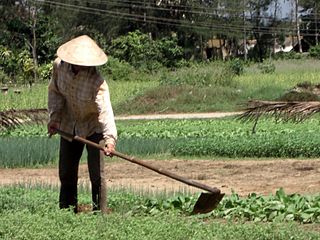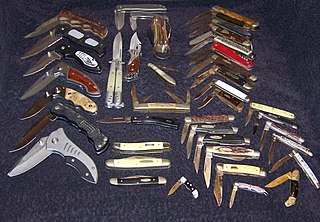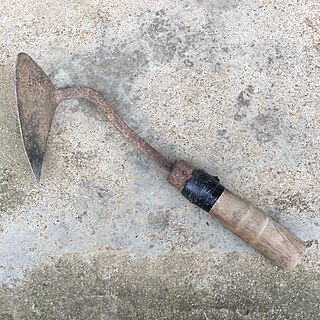
A hori-hori, sometimes referred to as a "soil knife" or a "weeding knife", is a heavy serrated multi-purpose steel blade for gardening jobs such as digging or cutting. The blade is sharp on both sides and comes to a semi-sharp point at the end.

A hori-hori, sometimes referred to as a "soil knife" or a "weeding knife", is a heavy serrated multi-purpose steel blade for gardening jobs such as digging or cutting. The blade is sharp on both sides and comes to a semi-sharp point at the end.
The hori-hori digging tool, first implemented in Japan, was originally used for carefully excavating plants such as Sansai in the mountains.[ citation needed ]
The word hori (ホリ) means "to dig" in Japanese and "hori-hori" is an onomatopoeia for a digging sound. The tool itself is commonly referred to in Japan as a "leisure knife" (レジャーナイフ, rejā naifu) or " Sansai knife" (山菜ナイフ, sansai naifu).[ citation needed ]
The hori-hori has uses in gardening such as weeding, cutting roots, transplanting, removing plants, sod cutting, and splitting perennials. The blade is made of carbon or stainless steel that is concave shaped to make it ideal for digging and prying. The blade has a large smooth wooden handle for comfortable use with one hand. It can serve as a small hand axe.
The size of the tool varies from 11 to 15 inches (280 to 380 mm) in total length, depending on the size of the handle. The size of the blade can vary, but it is normally around 6+7⁄8 inches (17 cm) × 1+3⁄4 inches (4.4 cm) A stainless-steel blade is often polished to a mirror-like finish, and is usually paired with a scabbard.
The blade is razor-sharp, and one edge is serrated for cutting through roots and tough soil. Functions include a knife, a saw, a digging tool, or as a measuring device for planting bulbs.

A knife is a tool or weapon with a cutting edge or blade, usually attached to a handle or hilt. One of the earliest tools used by humanity, knives appeared at least 2.5 million years ago, as evidenced by the Oldowan tools. Originally made of wood, bone, and stone, over the centuries, in step with improvements in both metallurgy and manufacturing, knife blades have been made from copper, bronze, iron, steel, ceramic, and titanium. Most modern knives have either fixed or folding blades; blade patterns and styles vary by maker and country of origin.
A saw is a tool consisting of a tough blade, wire, or chain with a hard toothed edge used to cut through material. Various terms are used to describe toothed and abrasive saws.

The kirpi is a small traditional hand weeding tool. It evolved in India as a multi-purpose gardening implement. The tool has a wooden handle and a curved blade. The cutting edge on the outside curve of the blade can be used for hand hoeing, while the serrated inside edge cuts through dead vegetation or tough roots. The pointed tip can be used for raking out deep roots.

A hoe is an ancient and versatile agricultural and horticultural hand tool used to shape soil, remove weeds, clear soil, and harvest root crops. Shaping the soil includes piling soil around the base of plants (hilling), digging narrow furrows (drills) and shallow trenches for planting seeds or bulbs. Weeding with a hoe includes agitating the surface of the soil or cutting foliage from roots, and clearing the soil of old roots and crop residues. Hoes for digging and moving soil are used to harvest root crops such as potatoes.

A Japanese kitchen knife is a type of a knife used for food preparation. These knives come in many different varieties and are often made using traditional Japanese blacksmithing techniques. They can be made from stainless steel, or hagane, which is the same kind of steel used to make Japanese swords. Most knives are referred to as hōchō or the variation -bōchō in compound words but can have other names including -kiri. There are four general categories used to distinguish the Japanese knife designs: handle, blade grind, steel, and construction.

A trowel is a small hand tool used for digging, applying, smoothing, or moving small amounts of viscous or particulate material. Common varieties include the masonry trowel, garden trowel, and float trowel.
A puukko is a small traditional Finnish general purpose belt knife with a single curved cutting edge, solid hidden tang and, usually, a flat spine. Military models of puukko were popular in the Russian criminal underworld under the name "Finnish knife" or finka since the 20th century. The modified version were among the models on which the Soviet military knife NR-40 was based and which was informally called "finka".

A kunai is a Japanese tool thought to be originally derived from the masonry trowel. The two widely recognized kinds are the short kunai and the big kunai. Although a basic tool, the kunai, in the hands of a martial arts expert, could be used as a multi-functional weapon. The kunai is commonly associated with the ninja, who in folklore use them to climb walls..

A garden fork, spading fork, or digging fork is a gardening implement, with a handle and a square-shouldered head featuring several short, sturdy tines. It is used for loosening, lifting and turning over soil in gardening and farming, and not to be confused with the pitchfork, a similar tined tool used for moving loose materials such as hay, straw, silage, and manure.

A pocketknife is a knife with one or more blades that fold into the handle. They are also known as jackknives (jack-knife), folding knives, EDC knife, or may be referred to as a penknife, though a penknife may also be a specific kind of pocketknife. A typical blade length is 5 to 15 centimetres.

The Opinel company has manufactured and marketed a line of eponymous wooden-handled knives since 1890 from its headquarters in Saint-Jean-de-Maurienne, Savoie, France where the family-run company also operates a museum dedicated to its knives. The company sells approximately 15 million knives annually. Opinel knives are made of both high carbon and stainless steel, the latter being Sandvik steel from Sweden.

A kitchen knife is any knife that is intended to be used in food preparation. While much of this work can be accomplished with a few general-purpose knives – notably a large chef's knife, a tough cleaver, a small paring knife and some sort of serrated blade – there are also many specialized knives that are designed for specific tasks. Kitchen knives can be made from several different materials.
In cooking, a chef's knife, also known as a cook's knife, is a cutting tool used in food preparation. The chef's knife was originally designed primarily to slice and disjoint large cuts of beef. Today it is the primary general-utility knife for most Western cooks.

A billhook or bill hook, also called a pruning knife or spar hook, is a versatile cutting tool used widely in agriculture and forestry for cutting woody material such as shrubs, small trees and branches. It is distinct from the sickle. It was commonly used in Europe with an important variety of traditional local patterns. Elsewhere, it was also developed locally such as in the Indian subcontinent, or introduced regionally as in the Americas, South Africa, and Oceania by European settlers.

A kitchen scraper is a kitchen implement made of metal, plastics, wood, rubber or silicone rubber. In practice, one type of scraper is often interchanged with another or with a spatula for some of the various uses.
A cane knife is a large hand-wielded cutting tool similar to a machete. Its use is prevalent in the harvesting of sugarcane in dominant cane-growing countries such as Peru, Brazil, Colombia, Australia, South Africa, Ecuador, Cuba, Jamaica, the Philippines and parts of the United States, especially Louisiana and Florida, as well as Hawaii. It is the primary tool used in countries that do not employ mechanical means for harvesting cane.

A cheese knife is a type of kitchen knife specialized for the cutting of cheese. Different cheeses require different knives, according primarily to hardness. There are also a number of other kitchen tools designed for cutting or slicing cheese, especially the harder types. These include the cheese cutter, cheese slicer, cheese plane, cheese scoop for soft cheese and others, collectively known as cheese servers.

A steak knife is a sharp table knife designed to efficiently and effectively cut steak. This type of knife comes in a variety of styles and sizes; however, the design often used in a steakhouse typically features a partially serrated blade and wood handle.

A fillet knife is a kitchen knife used for filleting. It gives good control and aids in filleting. It is a very flexible member of the boning knife family that is used to filet and prepare fish. Fillet knife blades are typically 15 to 28 cm long. This allows them to move easily along the backbone and under the skin of meat.

Homi, also known as a Korean hand plow, is a short-handled traditional farming tool used by Koreans. It is a farming tool that removes grasses from paddies and fields. It is also used when plowing a rice field, planting seeds, plowing up soil, and digging potatoes in fields. It is a farming tool similar to the hoe. It is an important extension of agriculture from the ancient times because the homi was excavated in the Bronze Age historic site of the Pyeongnam Mangsan Daepyeong-ri and the early Iron Age historic site of Yangpyong, Gyeonggi Province.